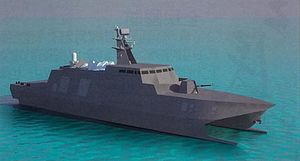The first of Taiwan’s so-called “carrier killer” ships was delivered to the Republic of China (ROC) Navy on Friday, according to local media.
Focus Taiwan reports that the Tuo River, a 500-ton stealthy twin-hull missile corvette, was christened by the ROC Navy earlier today. As the report explained, “The twin-hull corvette, described as a ‘carrier-killer’ by local media, has a maximum speed of 38 knots (70 kilometers per hour) and a range of 2,000 nautical miles. Its speed and low radar signature allows the corvette to get close to enemy targets.”
It is the first of what is expected to be 12 ships built in Taiwan under the Hsun Hai (Swift Sea) program. The program was first announced publicly in 2009, although Taiwan’s legislature waited until 2011 to authorize NT$24.98 billion (US$853.4 million) in funding for the program.
Originally, the program was supposed to yield between 7 and 11 vessels, but that number is believed to have been upped to as many as 12.
The new missile corvettes are seen as the successors for Taiwan’s Kuang Hua VI (KH-6) fast-attack boats. The ROC Navy’s has around 31 of the 170-ton KH-6s, which boast Hsiung Feng II (HF-2) anti-ship missiles. The new 500-ton fast attack boats pack a much greater punch, with eight Hsiung Feng II (HF-2) and Hsiung Feng III (HF-3) anti-ship missiles, as well as a 76mm rapid-fire bow gun, according to J. Michael Cole.
In a 2012 report for Taipei Times, Cole noted that the new fast attack ships were being designed with stability in mind, given the rough waters in the Taiwan Strait. The KH-6 had been widely criticized as too fragile to operate in these waters. Cole also explained at the time, “Special attention has reportedly been paid to the stealth design for the hull and main gun turret, which will use radar refractive materials.”
Writing around the same time for The Diplomat, Jim Holmes noted that the computer generated models of the proposed fast attack boats bore some resemblance to the United States’ Littoral Combat Ship (LCS). The USS Independence, the first of the LCS, is much longer and heavier than the Tuo River, and has a much greater range, however it is only slighter faster and both vessels envision a crew of roughly 40 sailors.
In the same article, Holmes also noted that Taiwan could no longer control the seas thanks to the modernization of the People’s Liberation Army Navy (PLAN). “What it can do,” Holmes continued:
is disperse large numbers of small combatants to hardened sites – caves, shelters, fishing ports – around the island’s rough coast. Such vessels could sortie to conduct independent operations against enemy shipping. Or, they could mass their firepower in concerted “wolf pack” attacks on major PLAN formations. While Taiwan is no longer mistress of the waters lapping against its shores, “sea denial” lies within its modest means.
This seems to be the envisioned purpose of the Swift Sea vessels.
It’s worth noting, however, that Taiwan’s larger strategic objective is to more tightly integrate itself into the regional order, in hopes of countering China’s bid to isolate it. For example, it recently signed trade agreements with New Zealand and Singapore, and a fishery agreement with Japan. Just this week, President Ma Ying-jeou reaffirmed Taiwan’s strong interest in joining the Trans-Pacific Partnership (TPP) and Regional Comprehensive Economic Partnership trade agreements.
Taiwan’s budding domestic defense industry could be an asset to this broader strategy. Specifically, while many developed nations are hesitant to sell arms to Taiwan, Taipei could sell some of its defense systems to Southeast Asian states like the Philippines. This would also serve the purpose of differentiating its claims to the South China Sea from mainland China’s claims to the same waters. Taiwan has pursued a similar strategy already in the East China Sea.
Regardless, the Tuo River will now undergo extensive testing before beginning its first deployment, which is expected in the first half of next year.
































